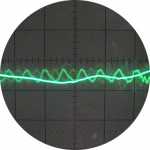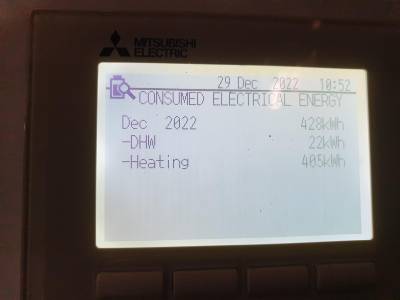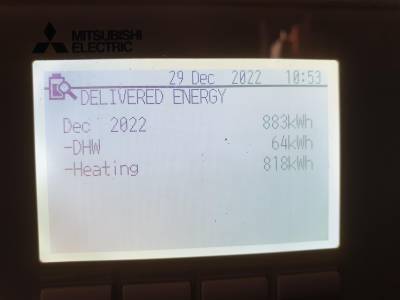Clarification needed for Ecodan ASHP settings
It may be useful if I explain a few things about how heat pump systems function and then you can decide how best to operate yours.
The heat pump gathers energy from both the electricity supply and the outside air. The warmer the outside air, the more energy it can provide, and hence less energy is required from the electricity supply.
When the outside air temperature is lower than the inside air temperature your home loses energy, as shown by the heat loss calculations, the colder the outside air temperature then the greater the heat loss.
To maintain a constant indoor temperature the heat pump needs to produce sufficient energy to match the heat loss, so as the outside air temperature gets colder the heat pump needs to work harder to produce more heat energy. The purpose of weather compensation is to try to match the heat energy produced by the heat pump to the heat loss of your home.
To keep your home at the desired temperature, the heat energy produced by the heat pump needs to be transferred to the heat emitters, your radiators and UFH. This is normally done by the water pump located inside your heat pump, but can also involved a further external water pump. Do you have an external water pump?
The amount of heat energy transferred from your heat emitters depends upon their size, and type, along with the temperature of the water being fed from the heat pump and the flow rate of that water. This is why most of the TRV's should be fully open to ensure adequate water flow. Since the size and type of heat emitters is fixed, the amount of heat energy is controlled by varying the water temperature and the water flow rate.
The setting of the weather compensation curve is used to vary the water temperature, and the heat pump controller varies the water flow rate by speeding up or slowing down the water pump.
If you require an upstairs temperature of 19C and a downstairs temperature of 15C, then I would expect your system to operate in the following manner. With your thermostat set at 21C and the TRV's fully open and your UFH set for 15C.
If the outside air temperature is 0C, then the heat pump should be warming the water to approximately 40C, as calculated by the weather compensation. If the downstairs temperature is below 15C then some of this warm water will be fed to the UFH pipework, until the temperature increases to 15C. If the upstairs temperature is below 21C then some of this warm water will be fed to the radiators. If the amount of heat energy coming from the radiators is greater than the heat loss, then the upstairs temperature will start to increase, but as the upstairs temperature rises then so will the heat loss. At some point the heat loss and energy supplied will balance and the upstairs temperature will remain constant.
If the upstairs temperature is above the desired 19C, the weather compensation setting is too high, but if the upstairs temperature is below 19C, then the weather compensation setting is too low.
What I would suggest in your situation is rather than lowering the weather compensation from 40C to 35C at an outside temperature of 0C, you should change the setting to 40C at an outside temperature of -5C. This will have the same effect of lowering the weather compensation curve, but will allow your system response to be maintained should the outside temperature fall to -5C.
By continuing to monitor the system, as you are doing, you should be able to fine tune your weather compensation curve until it closely matches the heat loss of your home. I would not suggest making any large changes and always allow time for the system to stabilise before making any further adjustments.
Thanks Derek - thats one of the best explanations Ive read!!
Funnily enough, changing the slope of the curve (as you suggested) was going to be my next thing to try.
Ill post back on here in a fortnight and give an update.
Cheers!
Hi, just thought Id give an update.
Its been quite a good time to test recently (not that Ive been testing particularly diligently or scientifically!) - we've had a temperatures ranging from -6c to 12c.
I currently have the comp curve set at -40c @ -5c outside, going down to 25c @ 15c outside. So far I feel this is about right for my rooms.
I open the TRVs fully in whatever room Im occupying. (Im either in my office for the most part, or in my bedroom). The stat is sat either in my office or bedroom. Its set to 20c, but it hardly ever gets to 20c so the heating is on all the time.
The Ecodan doesnt let me go below 25c, which got me thinking whether that was a safety feature. Is there any negatives to having the comp curve set as low as I have it? (cycling etc...)
I still cant get a COP better than ~2.1 (I never have, even when it was first installed 4 years ago!), so I dont know if Im reading the Ecodan incorrectly. I dont think I am becuase its a basic case of reading the Consumption and Delivered figure and dividing one by the other.
Cheers
Posted by: @tuftyHi, just thought Id give an update.
Its been quite a good time to test recently (not that Ive been testing particularly diligently or scientifically!) - we've had a temperatures ranging from -6c to 12c.
I currently have the comp curve set at -40c @ -5c outside, going down to 25c @ 15c outside. So far I feel this is about right for my rooms.
I open the TRVs fully in whatever room Im occupying. (Im either in my office for the most part, or in my bedroom). The stat is sat either in my office or bedroom. Its set to 20c, but it hardly ever gets to 20c so the heating is on all the time.
The Ecodan doesnt let me go below 25c, which got me thinking whether that was a safety feature. Is there any negatives to having the comp curve set as low as I have it? (cycling etc...)
I still cant get a COP better than ~2.1 (I never have, even when it was first installed 4 years ago!), so I don't know if Im reading the Ecodan incorrectly. I dont think I am becuase its a basic case of reading the Consumption and Delivered figure and dividing one by the other.
Cheers
Your curve looks fine if it works for you. You can change the flow temp settings; it's in Operation Settings - Heating Operation - Flow Temp Range. I think the minimum is 20.
Your COP still seems a bit low. Do you have a buffer, low loss header or similar? They can sometimes cause lower efficiency. Mine has never been that low and my flow temps are a bit higher than yours now.
How do I find out if I have a buffer, low loss header or similar? If I do have one, is it a case of turning it off?
Ive just taken a photo showing the Consumed/Delivered:
Consumed: 428kwh (22 HW; 405 Heating)
Delivered: 883kwh (64 HW; 818 Heating)
COP 2.06 overall (2.9 HW; 2.01 Heating)
Hot water has always had a COP of ~2.8, whereas Heating has never had a COP of more than ~2.2 .
Posted by: @kev-mYour curve looks fine if it works for you. You can change the flow temp settings; it's in Operation Settings - Heating Operation - Flow Temp Range. I think the minimum is 20.
Your COP still seems a bit low. Do you have a buffer, low loss header or similar? They can sometimes cause lower efficiency. Mine has never been that low and my flow temps are a bit higher than yours now.
Ive just dug out the gubbins the installers gave me and in the Material List they have "Low Loss Header for maximised efficiency, avoiding short cycling of ASHP". So I have got a Low Loss Header. Now I know this, is there something else I can do to try and get a better COP?
- 26 Forums
- 2,396 Topics
- 54.3 K Posts
- 353 Online
- 6,077 Members
Join Us!
Worth Watching
Latest Posts
-
RE: Recommended home battery inverters + regulatory matters - help requested
To me that makes sense. Bond the inverter neutral to t...
By JamesPa , 13 minutes ago
-

RE: Power outages and storms: A surprisingly good DNO experience
To be fair, the interactions I’ve been having recently ...
By Majordennisbloodnok , 36 minutes ago
-

RE: Setback savings - fact or fiction?
As far as I am aware, the majority, if not all, of the ...
By cathodeRay , 2 hours ago
-
RE: Advice for a novice on Mitsubishi Ecodan 6kW
Fair point. The highest frequency of defrosts I'd seen...
By Sheriff Fatman , 13 hours ago
-

RE: Heatpunk Floor plan issues
It's usually the complete opposite... seldom that Safar...
By Mars , 13 hours ago
-
RE: RDSAP10 effect on existing heat pump EPC rating?
@mike-patrick interesting update - thanks.I've been thr...
By Tim441 , 14 hours ago
-

RE: Fan is clipping ice build up from the front of unit.
@majordennisbloodnok I’ll not go there thanks! Toodles.
By Toodles , 16 hours ago
-

RE: Running from backup generaor in powercut?
@majordennisbloodnok Back in the 80’ or 90’ we had a te...
By Toodles , 16 hours ago
-
RE: Running my new Nibe ASHP efficiently
I'm new to the forum. Did you get a reply to this last ...
By Mike @ Camelot , 18 hours ago
-

RE: ASHP Energy Consumption: Aira 12kW heat pump
@grantmethestrength MCS requirements for DHW capacity h...
By Toodles , 18 hours ago
-
RE: New Mitsubishi Ecodan 11.2kW installation - L9 errors and maybe more
Great to hear! I just figured this out a day or tw...
By anotherdaveuk , 19 hours ago
-
RE: Help me keep the faith with my air source heat pump installation
@adamk I'm observing my own system at low temperatures ...
By dr_dongle , 1 day ago
-

RE: Free Ecoheat Heat Pump Install
@deltona Yes older houses are problematic like that, bu...
By bontwoody , 2 days ago
-
RE: Radiator sizing sanity check
As I mentioned early on the cost of supplying and fitti...
By JamesPa , 2 days ago
-
RE: Electricity price predictions
Great point, one of the key ones in my chat with Octopu...
By Batpred , 2 days ago
-

RE: New Fogstar 15.5kWh upright solution
Let me point out that there are many Chinese suppliers ...
By Transparent , 3 days ago
-

RE: Weather compensation- why you should use it
@majordennisbloodnok — The Two Ronnies Mastermind sketc...
By cathodeRay , 3 days ago
-
Just realised that this image of the cylinder cupboard ...
By Sheriff Fatman , 3 days ago
-

RE: Rodents! A word of warning for heat pump owners
Two thoughts: 1: Let's ask @david-s if Primary Pro in...
By Transparent , 3 days ago







